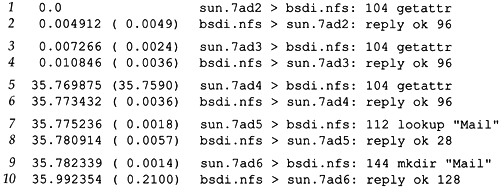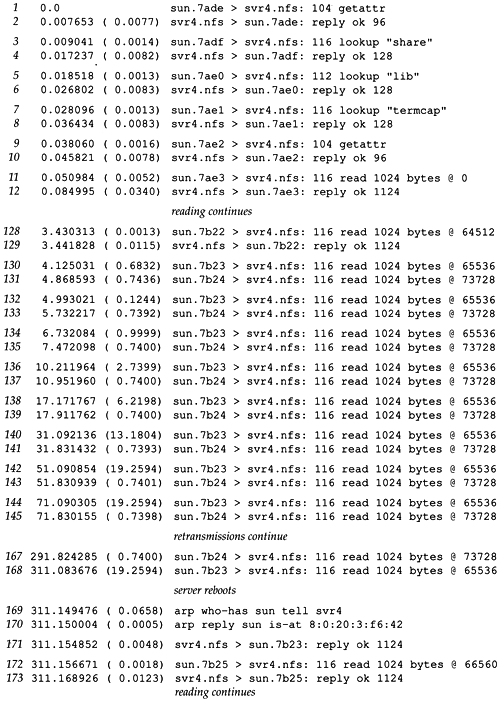29.6 NFS Examples
29.6 NFS Examples
Let's use tcpdump to see which NFS procedures are invoked by the client for typical file operations. When tcpdump detects a UDP datagram containing an RPC call ( call equals 0 in Figure 29.1) with a destination port of 2049, it decodes the datagram as an NFS request. Similarly if the UDP datagram is an RPC reply ( reply equals 1 in Figure 29.2) with a source port of 2049, it decodes the datagram as an NFS reply.
Simple Example: Reading a File
Our first example just copies a file to the terminal using the cat (1) command, but the file is on an NFS server:
sun % cat /nfs/bsdi/usr/rstevens/hello.c copy file to terminal main() { printf("hello, world\n"); } On the host sun (the NFS client) the filesystem /nfs/bsdi/usr is really the /usr filesystem on the host bsdi (the NFS server), as shown in Figure 29.6. The kernel on sun detects this when cat opens the file, and uses NFS to access the file. Figure 29.7 shows the tcpdump output.
Figure 29.7. NFS operations to read a file.

When tcpdump decodes an NFS request or reply, it prints the XID field for the client, instead of the port number. The XID field in lines 1 and 2 is 0x7aa6.
The filename /nfs/bsdi/usr/rstevens/hello.c is processed by the open function in the client kernel one element at a time. When it reaches /nfs/bsdi/usr it detects that this is a mount point to an NFS mounted filesystem.
In line 1 the client calls the GETATTR procedure to fetch the attributes of the server's directory that the client has mounted ( /usr ). This RPC request contains 104 bytes of data, exclusive of the IP and UDP headers. The reply in line 2 has a return value of OK and contains 96 bytes of data, exclusive of the IP and UDP headers. We see in this figure that the minimum NFS message contains around 100 bytes of data.
In line 3 the client calls the LOOKUP procedure for the file rstevens and receives an OK reply in line 4. The LOOKUP specifies the filename rstevens and the file handle that was saved by the kernel when the remote filesystem was mounted. The reply contains a new file handle that is used in the next step.
In line 5 the client does a LOOKUP of hello.c using the file handle from line 4. It receives another file handle in line 6. This new file handle is what the client uses in lines 7 and 9 to reference the file /nfs/bsdi/usr/rstevens/hello.c. We see that the client does a LOOKUP for each component of the pathname that is being opened.
In line 7 the client does another GETATTR, followed by a READ in line 9. The client asks for 1024 bytes, starting at offset 0, but receives less. (After subtracting the sizes of the RPC fields, and the other values returned by the READ procedure, 38 bytes of data are returned in line 10. This is indeed the size of the file hello.c. )
In this example the user process knows nothing about these NFS requests and replies that are being done by the kernel. The application just calls the kernel's open function, which causes 3 requests and 3 replies to be exchanged (lines 1 “6), and then calls the kernel's read function, which causes 2 requests and 2 replies (lines 7 “10). It is transparent to the client application that the file is on an NFS server.
Simple Example: Creating a Directory
As another simple example we'll change our working directory to a directory that's on an NFS server, and then create a new directory:
sun % cd /nfs/bsdi/usr/rstevens change working directory sun % mkdir Mail and create a directory
Figure 29.8 shows the tcpdump output.
Figure 29.8. NFS operations for cd to NFS directory, then mkdir.

Changing our directory causes the client to call the GETATTR procedure twice (lines 1 “4). When we create the new directory, the client calls the GETATTR procedure (lines 5 and 6), followed by a LOOKUP (lines 7 and 8, to verify that the directory doesn't already exist), followed by a MKDIR to create the directory (lines 9 and 10). The reply of OK in line 8 doesn't mean that the directory exists. It just means the procedure returned. tcpdump doesn't interpret the return values from the NFS procedures. It normally prints OK and the number of bytes of data in the reply.
Statelessness
One of the features of NFS ( critics of NFS would call this a wart, not a feature) is that the NFS server is stateless. The server does not keep track of which clients are accessing which files. Notice in the list of NFS procedures shown earlier that there is not an open procedure or a close procedure. The LOOKUP procedure is similar to an open, but the server never knows if the client is really going to reference the file after the client does a LOOKUP.
The reason for a stateless design is to simplify the crash recovery of the server after it crashes and reboots.
Example: Server Crash
In the following example we are reading a file from an NFS server when the server crashes and reboots. This shows how the stateless server approach lets the client "not know" that the server crashes. Other than a time pause while the server crashes and reboots, the client is unaware of the problem, and the client application is not affected.
On the client sun we start a cat of a long file ( /usr/share/lib/termcap on the NFS server svr4 ), disconnect the Ethernet cable during the transfer, shut down and reboot the server, then reconnect the cable. The client was configured to read 1024 bytes per NFS read. Figure 29.9 shows the tcpdump output.
Figure 29.9. Client reading a file when an NFS server crashes and reboots.

Lines 1 “10 correspond to the client opening the file. The operations are similar to those shown in Figure 29.7. In line 11 we see the first READ of the file, with 1024 bytes of data returned in line 12. This continues (a READ of 1024 followed by a reply of OK) through line 129.
In lines 130 and 131 we see two requests that time out and are retransmitted in lines 132 and 133. The first question is why are there two read requests, one starting at offset 65536 and the other starting at 73728? The client kernel has detected that the client application is performing sequential reads, and is trying to prefetch data blocks. (Most Unix kernels do this read-ahead. ) The client kernel is also running multiple NFS block I/O daemons ( biod processes) that try to generate multiple RPC requests on behalf of clients. One daemon is reading 8192 bytes starting at 65536 (in 1024-byte chunks ) and the other is performing the read-ahead of 8192 bytes starting at 73728.
Client retransmissions occur in lines 132 “168. In line 169 we see the server has rebooted, and it sends an ARP request before it can reply to the client's NFS request in line 168. The response to line 168 is sent in line 171. The client READ requests continue.
The client application never knows that the server crashes and reboots, and except for the 5-minute pause between lines 129 and 171, this server crash is transparent to the client.
To examine the timeout and retransmission interval in this example, realize that there are two client daemons with their own timeouts. The intervals for the first daemon (reading at offset 65536), rounded to two decimal points, are: 0.68, 0.87, 1.74, 3.48, 6.96, 13.92, 20.0, 20.0, 20.0, and so on. The intervals for the second daemon (reading at offset 73728) are the same (to two decimal points). It appears that these NFS clients are using a timeout that is a multiple of 0.875 seconds with an upper bound of 20 seconds. After each timeout the retransmission interval is doubled : 0.875, 1.75, 3.5, 7.0, and 14.0.
How long does the client retransmit? The client has two options that affect this. First, if the server filesystem is mounted hard, the client retransmits forever, but if the server filesystem is mounted soft, the client gives up after a fixed number of retransmissions. Also, with a hard mount the client has an option of whether to let the user interrupt the infinite retransmissions or not. If the client host specifies interruptibility when it mounts the server's filesystem, if we don't want to wait 5 minutes for the server to reboot after it crashes, we can type our interrupt key to abort the client application.
Idempotent Procedures
An RPC procedure is called idempotent if it can be executed more than once by the server and still return the same result. For example, the NFS read procedure is idempotent. As we saw in Figure 29.9, the client just reissues a given READ call until it gets a response. In our example the reason for the retransmission was that the server had crashed. If the server hasn't crashed, and the RPC reply message is lost (since UDP is unreliable), the client just retransmits and the server performs the same READ again. The same portion of the same file is read again and sent back to the client.
This works because each READ request specifies the starting offset of the read. If there were an NFS procedure asking the server to read the next N bytes of a file, this wouldn't work. Unless the server is made stateful (as opposed to stateless), if a reply is lost and the client reissues the READ for the next N bytes, the result is different. This is why the NFS READ and WRITE procedures have the client specify the starting offset. The client maintains the state (the current offset of each file), not the server.
Unfortunately, not all filesystem operations are idempotent. For example, consider the following steps: the client NFS issues the REMOVE request to delete a file; the server NFS deletes the file and responds OK; the server's response is lost; the client NFS times out and retransmits the request; the server NFS can't find the file and responds with an error; the client application receives an error saying the file doesn't exist. This error return to the client application is wrong ” the file did exist and was deleted.
The NFS operations that are idempotent are: GETATTR, STATFS, LOOKUP, READ, WRITE, READLINK, and READDIR. The procedures that are not idempotent are: CREATE, REMOVE, RENAME, LINK, SYMLINK, MKDIR, and RMDIR. SETATTR is normally idempotent, unless it's being used to truncate a file.
Since lost responses can always happen with UDP, NFS servers need a way to handle the nonidempotent operations. Most servers implement a recent-reply cache in which they store recent replies for the nonidempotent operations. Each time the server receives a request, it first checks this cache, and if a match is found, returns the previous reply instead of calling the NFS procedure again. [Juszczak 1989] provides details on this type of cache.
This concept of idempotent server procedures applies to any UDP-based application, not just NFS. The DNS, for example, provides an idempotent service. A DNS server can execute a resolver's request any number of times with no ill effects (other than wasted network resources).
EAN: 2147483647
Pages: 378